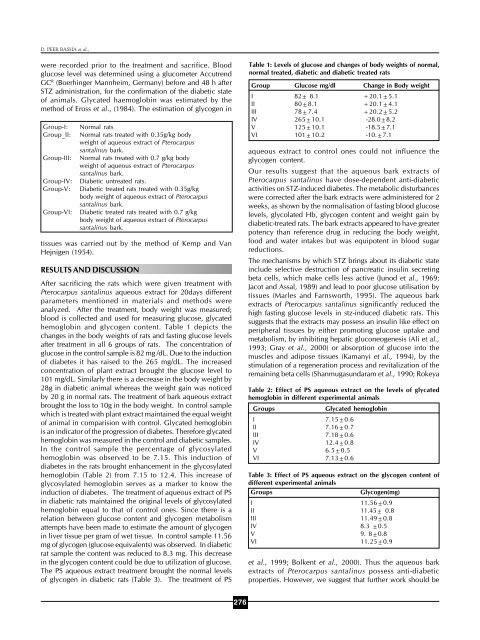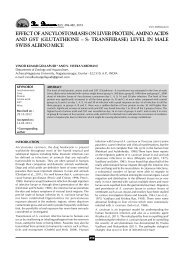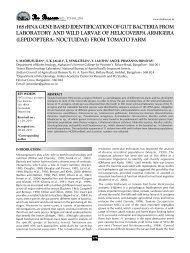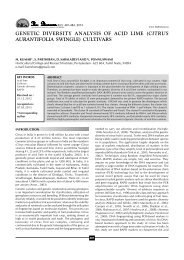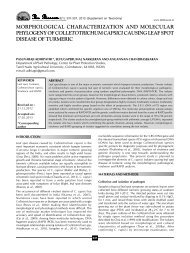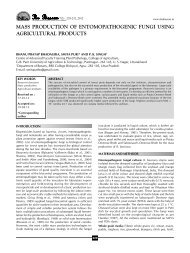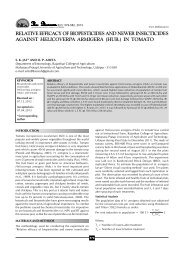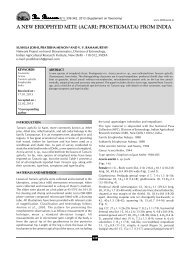full paper - THE BIOSCAN
full paper - THE BIOSCAN
full paper - THE BIOSCAN
Create successful ePaper yourself
Turn your PDF publications into a flip-book with our unique Google optimized e-Paper software.
D. PEER BASHA et al.,<br />
were recorded prior to the treatment and sacrifice. Blood<br />
glucose level was determined using a glucometer Accutrend<br />
GC R (Boerhinger Mannheim, Germany) before and 48 h after<br />
STZ administration, for the confirmation of the diabetic state<br />
of animals. Glycated haemoglobin was estimated by the<br />
method of Eross et al., (1984). The estimation of glycogen in<br />
Group-I:<br />
Group_II:<br />
Group-III:<br />
Group-IV:<br />
Group-V:<br />
Group-VI:<br />
Normal rats<br />
Normal rats treated with 0.35g/kg body<br />
weight of aqueous extract of Pterocarpus<br />
santalinus bark.<br />
Normal rats treated with 0.7 g/kg body<br />
weight of aqueous extract of Pterocarpus<br />
santalinus bark.<br />
Diabetic untreated rats.<br />
Diabetic treated rats treated with 0.35g/kg<br />
body weight of aqueous extract of Pterocarpus<br />
santalinus bark.<br />
Diabetic treated rats treated with 0.7 g/kg<br />
body weight of aqueous extract of Pterocarpus<br />
santalinus bark.<br />
tissues was carried out by the method of Kemp and Van<br />
Hejnigen (1954).<br />
RESULTS AND DISCUSSION<br />
After sacrificing the rats which were given treatment with<br />
Pterocarpus santalinus aqueous extract for 20days different<br />
parameters mentioned in materials and methods were<br />
analyzed. After the treatment, body weight was measured;<br />
blood is collected and used for measuring glucose, glycated<br />
hemoglobin and glycogen content. Table 1 depicts the<br />
changes in the body weights of rats and fasting glucose levels<br />
after treatment in all 6 groups of rats. The concentration of<br />
glucose in the control sample is 82 mg /dL. Due to the induction<br />
of diabetes it has raised to the 265 mg/dL. The increased<br />
concentration of plant extract brought the glucose level to<br />
101 mg/dL. Similarly there is a decrease in the body weight by<br />
28g in diabetic animal whereas the weight gain was noticed<br />
by 20 g in normal rats. The treatment of bark aqueous extract<br />
brought the loss to 10g in the body weight. In control sample<br />
which is treated with plant extract maintained the equal weight<br />
of animal in comparision with control. Glycated hemoglobin<br />
is an indicator of the progression of diabetes. Therefore glycated<br />
hemoglobin was measured in the control and diabetic samples.<br />
In the control sample the percentage of glycosylated<br />
hemoglobin was observed to be 7.15. This induction of<br />
diabetes in the rats brought enhancement in the glycosylated<br />
hemoglobin (Table 2) from 7.15 to 12.4. This increase of<br />
glycosylated hemoglobin serves as a marker to know the<br />
induction of diabetes. The treatment of aqueous extract of PS<br />
in diabetic rats maintained the original levels of glycosylated<br />
hemoglobin equal to that of control ones. Since there is a<br />
relation between glucose content and glycogen metabolism<br />
attempts have been made to estimate the amount of glycogen<br />
in liver tissue per gram of wet tissue. In control sample 11.56<br />
mg of glycogen (glucose equivalents) was observed. In diabetic<br />
rat sample the content was reduced to 8.3 mg. This decrease<br />
in the glycogen content could be due to utilization of glucose.<br />
The PS aqueous extract treatment brought the normal levels<br />
of glycogen in diabetic rats (Table 3). The treatment of PS<br />
Table 1: Levels of glucose and changes of body weights of normal,<br />
normal treated, diabetic and diabetic treated rats<br />
Group Glucose mg/dl Change in Body weight<br />
I 82± 8.1 +20.1±5.1<br />
II 80±8.1 +20.1±4.1<br />
III 78±7.4 +20.2±5.2<br />
IV 265±10.1 -28.0±8.2<br />
V 125±10.1 -18.5±7.1<br />
VI 101±10.2 -10.±7.1<br />
aqueous extract to control ones could not influence the<br />
glycogen content.<br />
Our results suggest that the aqueous bark extracts of<br />
Pterocarpus santalinus have dose-dependent anti-diabetic<br />
activities on STZ-induced diabetes. The metabolic disturbances<br />
were corrected after the bark extracts were administered for 2<br />
weeks, as shown by the normalisation of fasting blood glucose<br />
levels, glycolated Hb, glycogen content and weight gain by<br />
diabetic-treated rats. The bark extracts appeared to have greater<br />
potency than reference drug in reducing the body weight,<br />
food and water intakes but was equipotent in blood sugar<br />
reductions.<br />
The mechanisms by which STZ brings about its diabetic state<br />
include selective destruction of pancreatic insulin secreting<br />
beta cells, which make cells less active (Junod et al., 1969;<br />
Jacot and Assal, 1989) and lead to poor glucose utilisation by<br />
tissues (Marles and Farnsworth, 1995). The aqueous bark<br />
extracts of Pterocarpus santalinus significantly reduced the<br />
high fasting glucose levels in stz-induced diabetic rats. This<br />
suggests that the extracts may possess an insulin like effect on<br />
peripheral tissues by either promoting glucose uptake and<br />
metabolism, by inhibiting hepatic gluconeogenesis (Ali et al.,<br />
1993; Gray et al., 2000) or absorption of glucose into the<br />
muscles and adipose tissues (Kamanyi et al., 1994), by the<br />
stimulation of a regeneration process and revitalization of the<br />
remaining beta cells (Shanmugasundaram et al., 1990; Rokeya<br />
Table 2: Effect of PS aqueous extract on the levels of glycated<br />
hemoglobin in different experimental animals<br />
Groups<br />
Glycated hemoglobin<br />
I 7.15±0.6<br />
II 7.16±0.7<br />
III 7.18±0.6<br />
IV 12.4±0.8<br />
V 6.5±0.5<br />
VI 7.13±0.6<br />
Table 3: Effect of PS aqueous extract on the glycogen content of<br />
different experimental animals<br />
Groups<br />
Glycogen(mg)<br />
I 11.56±0.9<br />
II 11.45± 0.8<br />
III 11.49±0.8<br />
IV 8.3 ±0.5<br />
V 9. 8±0.8<br />
VI 11.25±0.9<br />
et al., 1999; Bolkent et al., 2000). Thus the aqueous bark<br />
extracts of Pterocarpus santalinus possess anti-diabetic<br />
properties. However, we suggest that further work should be<br />
276


